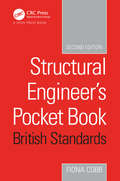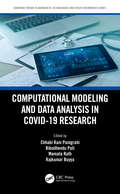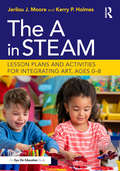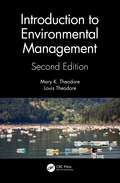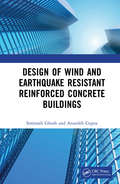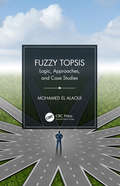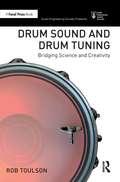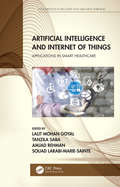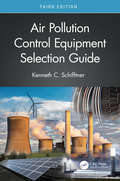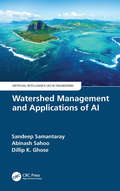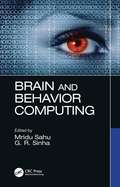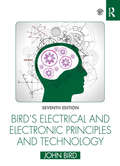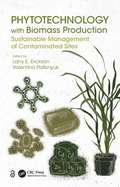- Table View
- List View
Structural Engineer's Pocket Book British Standards Edition
by Fiona CobbThe Structural Engineer's Pocket Book British Standards Edition is the only compilation of all tables, data, facts and formulae needed for scheme design to British Standards by structural engineers in a handy-sized format. Bringing together data from many sources into a compact, affordable pocketbook, it saves valuable time spent tracking down information needed regularly. This second edition is a companion to the more recent Eurocode third edition. Although small in size, this book contains the facts and figures needed for preliminary design whether in the office or on-site. Based on UK conventions, it is split into 14 sections including geotechnics, structural steel, reinforced concrete, masonry and timber, and includes a section on sustainability covering general concepts, materials, actions and targets for structural engineers.
Computational Modeling and Data Analysis in COVID-19 Research (Emerging Trends in Biomedical Technologies and Health informatics)
by Chhabi Rani Panigrahi Bibudhendu Pati Mamata Rath Rajkumar BuyyaThis book covers recent research on the COVID-19 pandemic. It includes the analysis, implementation, usage, and proposed ideas and models with architecture to handle the COVID-19 outbreak. Using advanced technologies such as artificial intelligence (AI) and machine learning (ML), techniques for data analysis, this book will be helpful to mitigate exposure and ensure public health. We know prevention is better than cure, so by using several ML techniques, researchers can try to predict the disease in its early stage and develop more effective medications and treatments. Computational technologies in areas like AI, ML, Internet of Things (IoT), and drone technologies underlie a range of applications that can be developed and utilized for this purpose. Because in most cases there is no one solution to stop the spreading of pandemic diseases, and the integration of several tools and tactics are needed. Many successful applications of AI, ML, IoT, and drone technologies already exist, including systems that analyze past data to predict and conclude some useful information for controlling the spread of COVID-19 infections using minimum resources. The AI and ML approach can be helpful to design different models to give a predictive solution for mitigating infection and preventing larger outbreaks. This book: Examines the use of artificial intelligence (AI), machine learning (ML), Internet of Things (IoT), and drone technologies as a helpful predictive solution for controlling infection of COVID-19 Covers recent research related to the COVID-19 pandemic and includes the analysis, implementation, usage, and proposed ideas and models with architecture to handle a pandemic outbreak Examines the performance, implementation, architecture, and techniques of different analytical and statistical models related to COVID-19 Includes different case studies on COVID-19 Dr. Chhabi Rani Panigrahi is Assistant Professor in the Department of Computer Science at Rama Devi Women’s University, Bhubaneswar, India. Dr. Bibudhendu Pati is Associate Professor and Head of the Department of Computer Science at Rama Devi Women’s University, Bhubaneswar, India. Dr. Mamata Rath is Assistant Professor in the School of Management (Information Technology) at Birla Global University, Bhubaneswar, India. Prof. Rajkumar Buyya is a Redmond Barry Distinguished Professor and Director of the Cloud Computing and Distributed Systems (CLOUDS) Laboratory at the University of Melbourne, Australia.
Computational Modeling and Data Analysis in COVID-19 Research (Emerging Trends in Biomedical Technologies and Health informatics)
by Chhabi Rani Panigrahi, Bibudhendu Pati, Mamata Rath and Rajkumar BuyyaThis book covers recent research on the COVID-19 pandemic. It includes the analysis, implementation, usage, and proposed ideas and models with architecture to handle the COVID-19 outbreak. Using advanced technologies such as artificial intelligence (AI) and machine learning (ML), techniques for data analysis, this book will be helpful to mitigate exposure and ensure public health. We know prevention is better than cure, so by using several ML techniques, researchers can try to predict the disease in its early stage and develop more effective medications and treatments. Computational technologies in areas like AI, ML, Internet of Things (IoT), and drone technologies underlie a range of applications that can be developed and utilized for this purpose. Because in most cases there is no one solution to stop the spreading of pandemic diseases, and the integration of several tools and tactics are needed. Many successful applications of AI, ML, IoT, and drone technologies already exist, including systems that analyze past data to predict and conclude some useful information for controlling the spread of COVID-19 infections using minimum resources. The AI and ML approach can be helpful to design different models to give a predictive solution for mitigating infection and preventing larger outbreaks. This book: Examines the use of artificial intelligence (AI), machine learning (ML), Internet of Things (IoT), and drone technologies as a helpful predictive solution for controlling infection of COVID-19 Covers recent research related to the COVID-19 pandemic and includes the analysis, implementation, usage, and proposed ideas and models with architecture to handle a pandemic outbreak Examines the performance, implementation, architecture, and techniques of different analytical and statistical models related to COVID-19 Includes different case studies on COVID-19 Dr. Chhabi Rani Panigrahi is Assistant Professor in the Department of Computer Science at Rama Devi Women’s University, Bhubaneswar, India. Dr. Bibudhendu Pati is Associate Professor and Head of the Department of Computer Science at Rama Devi Women’s University, Bhubaneswar, India. Dr. Mamata Rath is Assistant Professor in the School of Management (Information Technology) at Birla Global University, Bhubaneswar, India. Prof. Rajkumar Buyya is a Redmond Barry Distinguished Professor and Director of the Cloud Computing and Distributed Systems (CLOUDS) Laboratory at the University of Melbourne, Australia.
The A in STEAM: Lesson Plans and Activities for Integrating Art, Ages 0–8
by Jerilou J Moore Kerry P HolmesDiscover new and exciting ways to teach STEM content through the arts in your early childhood program with this innovative and comprehensive guidebook. Chapters feature playful activities divided by age band that bridge early academic learning and social, emotional, physical, and mental development with active engagement in the arts. Structured activities include a materials list, safety concerns, key takeaways, and related readings, as well as explicit connections to research and national standards. With clear and concise lesson plans that walk you through activities in music, dance, media arts, visual arts, and theater, it becomes easy to bring development and learning through movement and creativity to your classroom or program.
The A in STEAM: Lesson Plans and Activities for Integrating Art, Ages 0–8
by Jerilou J Moore Kerry P HolmesDiscover new and exciting ways to teach STEM content through the arts in your early childhood program with this innovative and comprehensive guidebook. Chapters feature playful activities divided by age band that bridge early academic learning and social, emotional, physical, and mental development with active engagement in the arts. Structured activities include a materials list, safety concerns, key takeaways, and related readings, as well as explicit connections to research and national standards. With clear and concise lesson plans that walk you through activities in music, dance, media arts, visual arts, and theater, it becomes easy to bring development and learning through movement and creativity to your classroom or program.
Introduction to Environmental Management
by Mary K. Theodore Louis TheodoreWritten at a level that is accessible to students in all disciplines, Introduction to Environmental Management, Second Edition translates complex environmental issues into practical and understandable terms. The book provides students and practitioners an understanding of the regulations, pollutants, and waste management issues that can be applied in various related environmental fields and industries. This new edition is updated throughout and adds eleven new chapters, including coverage of water conservation, water toxins, measurement methods, desalination, industrial ecology, legal issues, and more. Features: Updated throughout and includes eleven all-new chapters Reviews the specialized literature on pollution prevention, sustainability, and the role of optimization in water treatment and related areas, as well as references for further reading Provides illustrative examples and case studies that complement the text throughout Includes ancillary exams and a solutions manual for adopting instructors This book serves as a complete teaching tool, offering a combination of insightful coverage, concise language, and convenient pedagogical features, and supplies practical guidance that will aid students and practitioners alike.
Introduction to Environmental Management
by Mary K. Theodore Louis TheodoreWritten at a level that is accessible to students in all disciplines, Introduction to Environmental Management, Second Edition translates complex environmental issues into practical and understandable terms. The book provides students and practitioners an understanding of the regulations, pollutants, and waste management issues that can be applied in various related environmental fields and industries. This new edition is updated throughout and adds eleven new chapters, including coverage of water conservation, water toxins, measurement methods, desalination, industrial ecology, legal issues, and more. Features: Updated throughout and includes eleven all-new chapters Reviews the specialized literature on pollution prevention, sustainability, and the role of optimization in water treatment and related areas, as well as references for further reading Provides illustrative examples and case studies that complement the text throughout Includes ancillary exams and a solutions manual for adopting instructors This book serves as a complete teaching tool, offering a combination of insightful coverage, concise language, and convenient pedagogical features, and supplies practical guidance that will aid students and practitioners alike.
Design of Wind and Earthquake Resistant Reinforced Concrete Buildings
by Somnath Ghosh Arundeb GuptaDesign of Wind and Earthquake Resistant Reinforced Concrete Buildings explains wind and seismic design issues of RCC buildings in brief and provides design examples based on recommendations of latest IS codes essential for industrial design. Intricate issues of RCC design are discussed which are supplemented by real-life examples. Guidelines are presented for evaluating the acceptability of wind-induced motions of tall buildings. Design methodologies for structures to deform well beyond their elastic limits, which is essential under seismic excitation, have been discussed in detail. Comparative discussion including typical design examples using recent British, Euro and American codes is also included. Features: Explains wind and earthquake resistant design issues, balancing theoretical aspects and design implications, in detail Discusses issues for designing the wind and earthquake resistant RCC structures Provides comprehensive understanding, analysis, design and detailing of the structures Includes a detailed discussion on IS code related to wind and earthquake resistant design and its comparison with Euro, British and American codes Contains architectural drawings and structural drawings along with STAAD Pro input and output files The book is aimed at researchers, professionals, graduate students in wind and earthquake engineering, design of RCC structures, modelling and analysis of structures, civil/infrastructure engineering.
Design of Wind and Earthquake Resistant Reinforced Concrete Buildings
by Somnath Ghosh Arundeb GuptaDesign of Wind and Earthquake Resistant Reinforced Concrete Buildings explains wind and seismic design issues of RCC buildings in brief and provides design examples based on recommendations of latest IS codes essential for industrial design. Intricate issues of RCC design are discussed which are supplemented by real-life examples. Guidelines are presented for evaluating the acceptability of wind-induced motions of tall buildings. Design methodologies for structures to deform well beyond their elastic limits, which is essential under seismic excitation, have been discussed in detail. Comparative discussion including typical design examples using recent British, Euro and American codes is also included. Features: Explains wind and earthquake resistant design issues, balancing theoretical aspects and design implications, in detail Discusses issues for designing the wind and earthquake resistant RCC structures Provides comprehensive understanding, analysis, design and detailing of the structures Includes a detailed discussion on IS code related to wind and earthquake resistant design and its comparison with Euro, British and American codes Contains architectural drawings and structural drawings along with STAAD Pro input and output files The book is aimed at researchers, professionals, graduate students in wind and earthquake engineering, design of RCC structures, modelling and analysis of structures, civil/infrastructure engineering.
Fuzzy TOPSIS: Logic, Approaches, and Case Studies
by Mohamed El AlaouiThis book aims to justify the use of fuzzy logic as a logic and as a theory in the decision-making context. It also discusses the development of the TOPSIS method (Technique for Order of Preference by Similarity to Ideal Solution) with related examples and MATLAB codes. This is the first book devoted to TOPSIS and its fuzzy versions. It presents the use of fuzzy logic as a logic and as a theory in the decision-making content and discusses the development of the TOPSIS method in classical and fuzzy context. The book justifies the use of fuzzy logic as an uncertainty theory and provides illustrative examples for each fuzzy TOPSIS extension, along with related MATLAB codes and case studies. This book is for Industrial Engineers, Operations Research Engineers, Systems Engineers, and Production Engineers working in the areas of Decision Analysis, Multi-Criteria Decision Making, and Multiple Objective Optimization.
Fuzzy TOPSIS: Logic, Approaches, and Case Studies
by Mohamed El AlaouiThis book aims to justify the use of fuzzy logic as a logic and as a theory in the decision-making context. It also discusses the development of the TOPSIS method (Technique for Order of Preference by Similarity to Ideal Solution) with related examples and MATLAB codes. This is the first book devoted to TOPSIS and its fuzzy versions. It presents the use of fuzzy logic as a logic and as a theory in the decision-making content and discusses the development of the TOPSIS method in classical and fuzzy context. The book justifies the use of fuzzy logic as an uncertainty theory and provides illustrative examples for each fuzzy TOPSIS extension, along with related MATLAB codes and case studies. This book is for Industrial Engineers, Operations Research Engineers, Systems Engineers, and Production Engineers working in the areas of Decision Analysis, Multi-Criteria Decision Making, and Multiple Objective Optimization.
Drum Sound and Drum Tuning: Bridging Science and Creativity (Audio Engineering Society Presents)
by Rob ToulsonDrum Sound and Drum Tuning assists drummers, sound engineers, and music students in learning critical skills related to drum sound and achieving an optimised and personalised drum kit set-up. The book covers the essential theories of percussion acoustics and develops this knowledge in order to facilitate creative approaches to drum tuning and professional-level recording and mixing of drums. All aspects of drumhead vibration, drumhead equalisation, and resonant drumhead coupling are de-mystified, alongside discussions relating to drumhead types, drum shell vibration, and tuning to musical intervals for different performance genres. The book develops drum sound theory and creative analysis into a detailed dissection of recording and production techniques specifically for drums, including discussions on studio technologies, room acoustics, microphone techniques, phase coherence, and mixing drums with advanced digital audio workstation (DAW) techniques and creative processing tools. Drum Sound and Drum Tuning includes many practical hands-on exercises that incorporate example tutorials with Logic Pro and iDrumTune Pro software, encouraging the reader to put theory into immediate creative practice and to develop their own listening skills in an informed and reflective manner. The book also documents primary interviews and opinion from some of the world’s most celebrated drummers, music producers, and sound engineers, enabling the reader to connect the relevant theories with real-world context, whilst refining their own personalised approach to mastering drum sound.
Drum Sound and Drum Tuning: Bridging Science and Creativity (Audio Engineering Society Presents)
by Rob ToulsonDrum Sound and Drum Tuning assists drummers, sound engineers, and music students in learning critical skills related to drum sound and achieving an optimised and personalised drum kit set-up. The book covers the essential theories of percussion acoustics and develops this knowledge in order to facilitate creative approaches to drum tuning and professional-level recording and mixing of drums. All aspects of drumhead vibration, drumhead equalisation, and resonant drumhead coupling are de-mystified, alongside discussions relating to drumhead types, drum shell vibration, and tuning to musical intervals for different performance genres. The book develops drum sound theory and creative analysis into a detailed dissection of recording and production techniques specifically for drums, including discussions on studio technologies, room acoustics, microphone techniques, phase coherence, and mixing drums with advanced digital audio workstation (DAW) techniques and creative processing tools. Drum Sound and Drum Tuning includes many practical hands-on exercises that incorporate example tutorials with Logic Pro and iDrumTune Pro software, encouraging the reader to put theory into immediate creative practice and to develop their own listening skills in an informed and reflective manner. The book also documents primary interviews and opinion from some of the world’s most celebrated drummers, music producers, and sound engineers, enabling the reader to connect the relevant theories with real-world context, whilst refining their own personalised approach to mastering drum sound.
Artificial Intelligence and Internet of Things: Applications in Smart Healthcare (Innovations in Big Data and Machine Learning)
by Lalit Mohan Goyal Tanzila Saba Amjad Rehman Souad Larabi-Marie-SainteThis book reveals the applications of AI and IoT in smart healthcare and medical systems. It provides core principles, algorithms, protocols, emerging trends, security problems, and the latest e-healthcare services findings.The book also provides case studies and discusses how AI and IoT applications such as wireless devices, sensors, and deep learning could play a major role in assisting patients, doctors, and pharmaceutical staff. It focuses on how to use AI and IoT to keep patients safe and healthy and, at the same time, empower physicians to deliver superlative care.This book is written for researchers and practitioners working in the information technology, computer science, and medical equipment manufacturing industry for products and services having basic- and high-level AI and IoT applications. The book is also a useful guide for academic researchers and students.
Artificial Intelligence and Internet of Things: Applications in Smart Healthcare (Innovations in Big Data and Machine Learning)
by Lalit Mohan GoyalThis book reveals the applications of AI and IoT in smart healthcare and medical systems. It provides core principles, algorithms, protocols, emerging trends, security problems, and the latest e-healthcare services findings.The book also provides case studies and discusses how AI and IoT applications such as wireless devices, sensors, and deep learning could play a major role in assisting patients, doctors, and pharmaceutical staff. It focuses on how to use AI and IoT to keep patients safe and healthy and, at the same time, empower physicians to deliver superlative care.This book is written for researchers and practitioners working in the information technology, computer science, and medical equipment manufacturing industry for products and services having basic- and high-level AI and IoT applications. The book is also a useful guide for academic researchers and students.
Air Pollution Control Equipment Selection Guide
by Kenneth C. SchifftnerThis new edition of Air Pollution Control Equipment Selection Guide builds upon the successes of previous editions that developed a detailed discussion on various technologies used for air pollution control. This book covers a wide range of equipment and provides a good overview of the related principles and applications. A particularly valuable feature are the practical examples, not commonly available in other books. Based on the author’s fifty years of experience in applying and operating air pollution control equipment, this book provides easy-to-read information on basic air pollution control technology and is the quintessential resource for the busy engineer and for those who do not have formal training in air pollution control.FEATURES OF THE THIRD EDITION Uniform and consistent applications information for comparing the effectiveness of different technologies. Provides answers to questions about how to reduce operating costs and how to achieve peak performance. Concise descriptions of each equipment with diagnostics and testing suggestions. New chapters on optimization techniques that help readers deal with different types of hardware for better performance and efficacy.
Air Pollution Control Equipment Selection Guide
by Kenneth C. SchifftnerThis new edition of Air Pollution Control Equipment Selection Guide builds upon the successes of previous editions that developed a detailed discussion on various technologies used for air pollution control. This book covers a wide range of equipment and provides a good overview of the related principles and applications. A particularly valuable feature are the practical examples, not commonly available in other books. Based on the author’s fifty years of experience in applying and operating air pollution control equipment, this book provides easy-to-read information on basic air pollution control technology and is the quintessential resource for the busy engineer and for those who do not have formal training in air pollution control.FEATURES OF THE THIRD EDITION Uniform and consistent applications information for comparing the effectiveness of different technologies. Provides answers to questions about how to reduce operating costs and how to achieve peak performance. Concise descriptions of each equipment with diagnostics and testing suggestions. New chapters on optimization techniques that help readers deal with different types of hardware for better performance and efficacy.
Watershed Management and Applications of AI (Artificial Intelligence (AI) in Engineering)
by Sandeep Samantaray Abinash Sahoo Dillip K. GhoseLand use and water resources are two major environmental issues which necessitate conservation, management, and maintenance practices through the use of various engineering techniques. Water scientists and environmental engineers must address the various aspects of flood control, soil conservation, rainfall-runoff processes, and groundwater hydrology. Watershed Management and Applications of AI provides the necessary principles of hydrology to provide practical strategies useful for the planning, design, and management of watersheds. The book also synthesizes novel new approaches, such as hydrological applications of machine learning using neural networks to predict runoff and using artificial intelligence for the prediction of groundwater fluctuations. Features: Presents hydrologic analysis and design along with soil conservation practices through proper watershed management techniques Provides analysis of land erosion and sediment transport in watersheds from small to large scale Includes estimations for runoff using different methodologies with systematic approaches for each Discusses water harvesting and development of water yield catchments This book will be a valuable resource for students in hydrology courses, environmental consultants, water resource engineers, and researchers in related water science and engineering fields.
Watershed Management and Applications of AI (Artificial Intelligence (AI) in Engineering)
by Sandeep Samantaray Abinash Sahoo Dillip K. GhoseLand use and water resources are two major environmental issues which necessitate conservation, management, and maintenance practices through the use of various engineering techniques. Water scientists and environmental engineers must address the various aspects of flood control, soil conservation, rainfall-runoff processes, and groundwater hydrology. Watershed Management and Applications of AI provides the necessary principles of hydrology to provide practical strategies useful for the planning, design, and management of watersheds. The book also synthesizes novel new approaches, such as hydrological applications of machine learning using neural networks to predict runoff and using artificial intelligence for the prediction of groundwater fluctuations. Features: Presents hydrologic analysis and design along with soil conservation practices through proper watershed management techniques Provides analysis of land erosion and sediment transport in watersheds from small to large scale Includes estimations for runoff using different methodologies with systematic approaches for each Discusses water harvesting and development of water yield catchments This book will be a valuable resource for students in hydrology courses, environmental consultants, water resource engineers, and researchers in related water science and engineering fields.
Brain and Behavior Computing
by Mridu Sahu G. R. SinhaBrain and Behavior Computing offers insights into the functions of the human brain. This book provides an emphasis on brain and behavior computing with different modalities available such as signal processing, image processing, data sciences, statistics further it includes fundamental, mathematical model, algorithms, case studies, and future research scopes. It further illustrates brain signal sources and how the brain signal can process, manipulate, and transform in different domains allowing researchers and professionals to extract information about the physiological condition of the brain. Emphasizes real challenges in brain signal processing for a variety of applications for analysis, classification, and clustering. Discusses data sciences and its applications in brain computing visualization. Covers all the most recent tools for analysing the brain and it’s working. Describes brain modeling and all possible machine learning methods and their uses. Augments the use of data mining and machine learning to brain computer interface (BCI) devices. Includes case studies and actual simulation examples. This book is aimed at researchers, professionals, and graduate students in image processing and computer vision, biomedical engineering, signal processing, and brain and behavior computing.
Bird's Electrical and Electronic Principles and Technology
by John BirdNow in its seventh edition, Bird’s Electrical and Electronic Principles and Technology introduces and covers theory through detailed examples and laboratory experiments, enabling students to gain knowledge required by technicians in fields such as engineering, electronics, and telecommunications. This edition includes several new sections, including glass batteries, climate change, the future of electricity production, and discussions concerning everyday aspects of electricity, such as watts and lumens, electrical safety, AC vs DC, and trending technologies. The extensive and thorough topic coverage makes this a great text for a range of level 2 and 3 engineering courses, which has helped thousands of students succeed in their exams. It is also suitable for BTEC First, National and Diploma syllabuses, City & Guilds Technician Certificate and Diploma syllabuses, and Foundation Degrees in engineering. Its companion website at www.routledge.com/cw/bird provides resources for both students and lecturers, including full solutions for all 900 further questions, lists of essential formulae, multiple-choice tests and illustrations, as well as full solutions to revision tests and lab experiments for course instructors.
Brain and Behavior Computing
by Mridu SahuBrain and Behavior Computing offers insights into the functions of the human brain. This book provides an emphasis on brain and behavior computing with different modalities available such as signal processing, image processing, data sciences, statistics further it includes fundamental, mathematical model, algorithms, case studies, and future research scopes. It further illustrates brain signal sources and how the brain signal can process, manipulate, and transform in different domains allowing researchers and professionals to extract information about the physiological condition of the brain. Emphasizes real challenges in brain signal processing for a variety of applications for analysis, classification, and clustering. Discusses data sciences and its applications in brain computing visualization. Covers all the most recent tools for analysing the brain and it’s working. Describes brain modeling and all possible machine learning methods and their uses. Augments the use of data mining and machine learning to brain computer interface (BCI) devices. Includes case studies and actual simulation examples. This book is aimed at researchers, professionals, and graduate students in image processing and computer vision, biomedical engineering, signal processing, and brain and behavior computing.
Bird's Electrical and Electronic Principles and Technology
by John BirdNow in its seventh edition, Bird’s Electrical and Electronic Principles and Technology introduces and covers theory through detailed examples and laboratory experiments, enabling students to gain knowledge required by technicians in fields such as engineering, electronics, and telecommunications. This edition includes several new sections, including glass batteries, climate change, the future of electricity production, and discussions concerning everyday aspects of electricity, such as watts and lumens, electrical safety, AC vs DC, and trending technologies. The extensive and thorough topic coverage makes this a great text for a range of level 2 and 3 engineering courses, which has helped thousands of students succeed in their exams. It is also suitable for BTEC First, National and Diploma syllabuses, City & Guilds Technician Certificate and Diploma syllabuses, and Foundation Degrees in engineering. Its companion website at www.routledge.com/cw/bird provides resources for both students and lecturers, including full solutions for all 900 further questions, lists of essential formulae, multiple-choice tests and illustrations, as well as full solutions to revision tests and lab experiments for course instructors.
Phytotechnology with Biomass Production: Sustainable Management of Contaminated Sites
by Larry E. Erickson Valentina PidlisnyukThis book explains the concept of using phytotechnology with biomass production to improve soil quality and restore contaminated sites to a useful state that has economic and social value. Phytotechnology with Biomass Production: Sustainable Management of Contaminated Sites focuses on the application of second-generation biofuel crops, primarily Miscanthus, to slightly contaminated or marginal postmilitary and postmining soils. Based on recent and ongoing research from the United States, Ukraine, the Czech Republic, and Germany, along with case studies from other countries, this is the first comprehensive book on using phytotechnology with biomass production at contaminated sites at a global level. FEATURES Focuses on an important topic of a growing global activity: soil improvement through biomass production Includes case studies and success stories from different countries on application of Miscanthus phytotechnology to sites differently contaminated by trace elements, pesticides, and petroleum products Discusses the peculiarities of Miscanthus production on postmilitary and postmining contaminated lands and the impact of plant growth regulators, soil amendments, fertilizers, and biochar to the process Introduces soil fauna as indicators of soil health during Miscanthus phytotechnology application Presents Miscanthus value chain associated with the processing of Miscanthus biomass to different bioproducts While written primarily for faculty, students, research scientists, environmental and agricultural professionals, gardeners, farmers, landowners, and government officials, this book has value for all who are working on phytotechnology projects and phytomining to reduce risk and/or improve soil quality at contaminated sites. Phytotechnology with Biomass Production: Sustainable Management of Contaminated Sites is also a great new resource for those who are new to the topic and want to learn to apply phytotechnologies and biomass production with further conversion into energy and bioproducts.
Phytotechnology with Biomass Production: Sustainable Management of Contaminated Sites
by Larry E. Erickson Valentina PidlisnyukThis book explains the concept of using phytotechnology with biomass production to improve soil quality and restore contaminated sites to a useful state that has economic and social value. Phytotechnology with Biomass Production: Sustainable Management of Contaminated Sites focuses on the application of second-generation biofuel crops, primarily Miscanthus, to slightly contaminated or marginal postmilitary and postmining soils. Based on recent and ongoing research from the United States, Ukraine, the Czech Republic, and Germany, along with case studies from other countries, this is the first comprehensive book on using phytotechnology with biomass production at contaminated sites at a global level. FEATURES Focuses on an important topic of a growing global activity: soil improvement through biomass production Includes case studies and success stories from different countries on application of Miscanthus phytotechnology to sites differently contaminated by trace elements, pesticides, and petroleum products Discusses the peculiarities of Miscanthus production on postmilitary and postmining contaminated lands and the impact of plant growth regulators, soil amendments, fertilizers, and biochar to the process Introduces soil fauna as indicators of soil health during Miscanthus phytotechnology application Presents Miscanthus value chain associated with the processing of Miscanthus biomass to different bioproducts While written primarily for faculty, students, research scientists, environmental and agricultural professionals, gardeners, farmers, landowners, and government officials, this book has value for all who are working on phytotechnology projects and phytomining to reduce risk and/or improve soil quality at contaminated sites. Phytotechnology with Biomass Production: Sustainable Management of Contaminated Sites is also a great new resource for those who are new to the topic and want to learn to apply phytotechnologies and biomass production with further conversion into energy and bioproducts.
